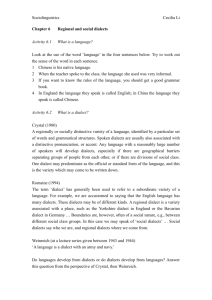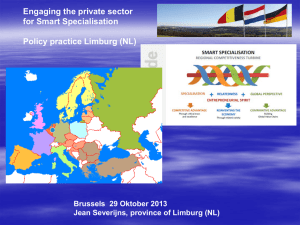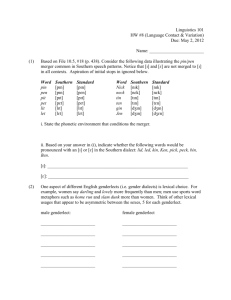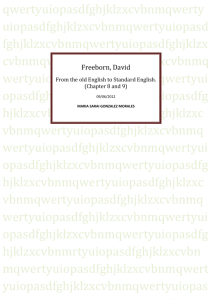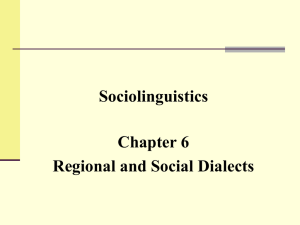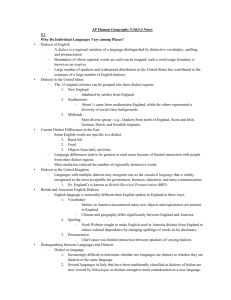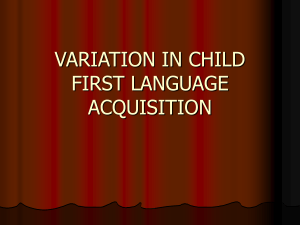All dialects are equal, but some dialects are more equal than others
advertisement
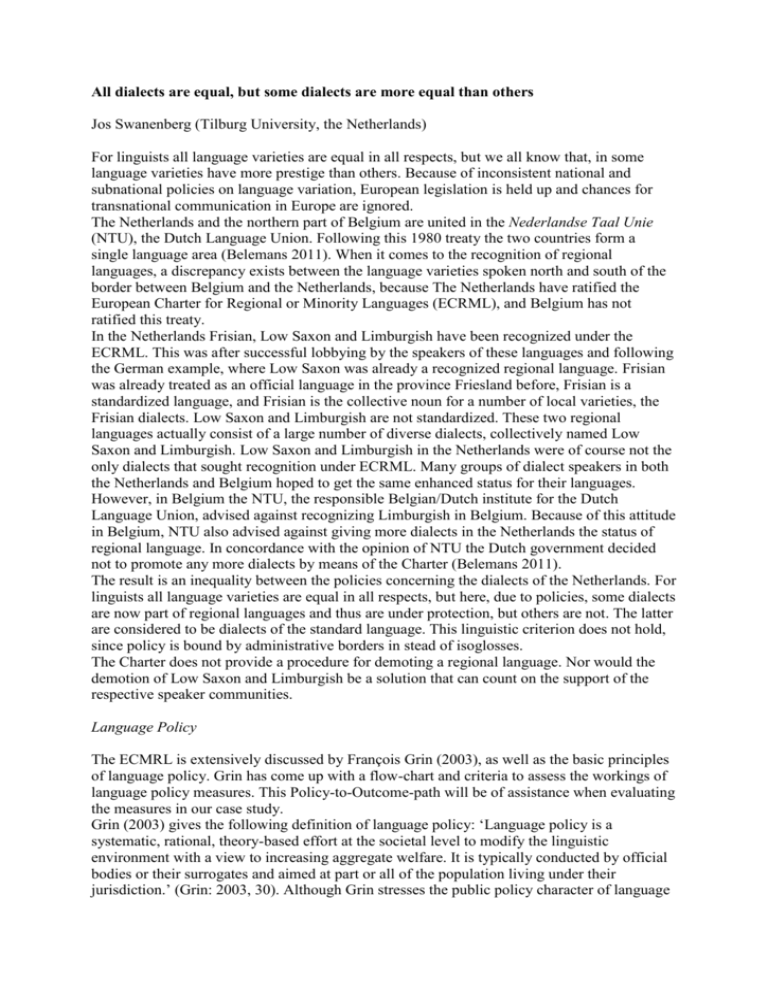
All dialects are equal, but some dialects are more equal than others Jos Swanenberg (Tilburg University, the Netherlands) For linguists all language varieties are equal in all respects, but we all know that, in some language varieties have more prestige than others. Because of inconsistent national and subnational policies on language variation, European legislation is held up and chances for transnational communication in Europe are ignored. The Netherlands and the northern part of Belgium are united in the Nederlandse Taal Unie (NTU), the Dutch Language Union. Following this 1980 treaty the two countries form a single language area (Belemans 2011). When it comes to the recognition of regional languages, a discrepancy exists between the language varieties spoken north and south of the border between Belgium and the Netherlands, because The Netherlands have ratified the European Charter for Regional or Minority Languages (ECRML), and Belgium has not ratified this treaty. In the Netherlands Frisian, Low Saxon and Limburgish have been recognized under the ECRML. This was after successful lobbying by the speakers of these languages and following the German example, where Low Saxon was already a recognized regional language. Frisian was already treated as an official language in the province Friesland before, Frisian is a standardized language, and Frisian is the collective noun for a number of local varieties, the Frisian dialects. Low Saxon and Limburgish are not standardized. These two regional languages actually consist of a large number of diverse dialects, collectively named Low Saxon and Limburgish. Low Saxon and Limburgish in the Netherlands were of course not the only dialects that sought recognition under ECRML. Many groups of dialect speakers in both the Netherlands and Belgium hoped to get the same enhanced status for their languages. However, in Belgium the NTU, the responsible Belgian/Dutch institute for the Dutch Language Union, advised against recognizing Limburgish in Belgium. Because of this attitude in Belgium, NTU also advised against giving more dialects in the Netherlands the status of regional language. In concordance with the opinion of NTU the Dutch government decided not to promote any more dialects by means of the Charter (Belemans 2011). The result is an inequality between the policies concerning the dialects of the Netherlands. For linguists all language varieties are equal in all respects, but here, due to policies, some dialects are now part of regional languages and thus are under protection, but others are not. The latter are considered to be dialects of the standard language. This linguistic criterion does not hold, since policy is bound by administrative borders in stead of isoglosses. The Charter does not provide a procedure for demoting a regional language. Nor would the demotion of Low Saxon and Limburgish be a solution that can count on the support of the respective speaker communities. Language Policy The ECMRL is extensively discussed by François Grin (2003), as well as the basic principles of language policy. Grin has come up with a flow-chart and criteria to assess the workings of language policy measures. This Policy-to-Outcome-path will be of assistance when evaluating the measures in our case study. Grin (2003) gives the following definition of language policy: ‘Language policy is a systematic, rational, theory-based effort at the societal level to modify the linguistic environment with a view to increasing aggregate welfare. It is typically conducted by official bodies or their surrogates and aimed at part or all of the population living under their jurisdiction.’ (Grin: 2003, 30). Although Grin stresses the public policy character of language policy, language planning does not necessarily only comprise activities executed by a central authority. Active individual citizens or NGOs can also lobby for language rights for example. The difference between language policy and language planning is that the first refers to the underlying general linguistic, political and social goals underlying the planning process (Mesthrie et al. 2000). Language planning in turn is used to refer to the practice; it includes all conscious attempts at altering linguistic behaviour of a speech community (Mesthrie et al. 2000: 384). There are two basic forms of language planning. Corpus planning is concerned with the internal structure of the language, and status planning comprises all efforts undertaken to change the use and function of a language or language variety within a given society (Kloss 1997). Status is used here to refer to ‘function’ or ‘domain’. It can comprise the entire spectrum of domains of language use; the legal, economical, social and political position of the language (Kloss 1997: 384-385). These different forms of language planning are naturally linked. An example of this relationship between corpus and status planning is seen when there is the desire to use a language in more domains of language use, for instance the use of Frisian in the legal profession. This is considered a form of status planning, concerned with where and when a language is used. To achieve this goal also corpus planning is involved, new lexical items, and appropriate styles are required (Mesthrie et al.: 2000, 385). An essential aspect of language planning is language standardization. This refers to the creation and establishment of a uniform linguistic norm. The degrees of standardization range from an ‘unstandardized oral language to a mature modern standard language’ (Mesthrie et al. 2000: 385). For example, English is a ‘mature modern standard language’. It is used in all areas of communication. Frisian could be considered a ‘young standard language' on this scale. Apart from vernacular speech the language is used to some degree in education and in administration. However, the language is not used in all areas of communication. The language is not used in the field of science or technology for instance. More recently scholars have distinguished two more dimensions in language planning; prestige planning and acquisition planning. The first, prestige planning, involves efforts to create a positive image of the language so the stimulation of the language will succeed in the long run. The latter, acquisition planning, stimulates people to learn the language in question. In practice language planning should be applied on a case-by-case basis. Not every language has the same needs (Grin 2003: 13). So, the same instruments which proof to be useful in promoting the use of Sámi in Finland are not necessarily as successful when applied to Frisian in the Netherlands for instance, because the language communities are different. Languages can obviously not exist without a community of speakers. A community needs a viable environment to live in, and people need the means to make a living. Take all that away and their language dies. Language death occurs when one language replaces another across all domains of language use, and when the parents no longer pass on the language to their children (Nettle & Romaine 2000: 4-7). A guideline to measure the vitality of a language is Fishman’s (2001) Graded Intergenerational Disruption Scale (GIDS). Apart from indicating risk the language faces of vanishing, the scale also offers targets and priorities which a regional or minority language can set to improve its position (Gorter 2008). It exists of eight stages on a scale of the ‘threatenedness’ of a language. At stage 8 the language is at its weakest, with hardly any native speakers left, and at stage 1 the language has successfully averted language shift. At stage 1 the language is not ‘done’ with language policy, but it has succeeded in creating an environment in which the use of the language is considered ‘normal’ and it thrives in a living language community able to reproduce itself (Grin 2003: 42). Reproduction, i.e. intergenerational native tongue transmission, is the key factor of Fishman’s approach. Language acquisition is very important; however, solely teaching the language in schools as a second language will not save a language. Transmission from parents to children is crucial for natural sustenance of a language (Gorter 2008). There is a division between stage 8-5 and stage 5-1. The weakest languages in stage 8-5 are mainly concerned with promoting the language to increase public support (Fishman 2001: 454), and do not necessarily need approval of those in power. This is different for the stronger languages, where the language is ready to be used in administration and education. The upheaval about the disappearance of the world’s languages begs the question why this is such a loss, and why linguistic diversity should be preserved. Answers to these questions come from different angles, which can roughly be divided to fit in a ‘biodiversity’ perspective, an economic welfare perspective, and a human rights point of view. The first perspective compares linguistic diversity to biodiversity, each language being compared to another, perhaps exotic, species. Linguists should save (collect) the languages just as a museum collects rare pieces of art. On the one hand, studying the world’s languages enables linguists to perfect their theories of language structure. On the other hand culture and language are intertwined. A culture can be preserved through language. The idea is that each language reflects a unique worldview; the different linguistic organizational structures reflect how humans organize their thoughts and experiences (Nettle & Romaine 2000: 10-14). From a welfare perspective the protection of linguistic diversity should be assessed empirically. A just policy should deliver more welfare to society as a whole. To achieve this, resources should be properly allocated. A policy, as a way of allocating resources, always creates ‘winners’ – those who benefit from it, and ‘losers’ those who do not benefit from it, but still have to pay in a way. This can be explained with an example of a taxpayer who pays taxes which finance a public service that he does not use. A good policy in theory is one where the winners can compensate the losers and still be better of. In respect to language policy this is however very hard to assess, as linguistic rights are difficult to express in monetary terms. Also there is hardly any empirical data which proof that society will be better or worse of with or without the protection of regional or minority language rights (Grin 2003: 25-27). Nevertheless, opponents of the protection of regional languages often claim that a monolinguistic environment will be more efficient, with a linguistically unified economic and social system. Majority languages should be most ‘useful’ because they have greater ‘social advancement’; something that the minority languages do not have. Following this line of reasoning these critics claim that language policies will only succeed when they correspond to labour-market considerations (Fishman 2001: 452-454). Fishman objects to this argument that not labour-market access is the problem, but economic power in general. A mere linguistic solution is not enough to straighten out the differences in economic power. Also, Fishman opposes the materialistic attitude the welfare-argument expresses, and argues that "human values, behaviours and identities are essentially non-materialistic in nature", e.g. family loyalty, aesthetics and the corpus of ethics that each vulture expresses and continually develops. He calls on the ‘mark of higher cultures’ that should have other than material values. Another objection Fishman makes is to the idea that language death is ‘natural’; a normal consequence of minority-majority relations. Fishman states that speakers of the minority language are uninformed, and are unaware of other options such as bilingualism (Fishman 2001: 454). Another widespread public opinion is that language right activists cause conflict, and minority languages are inherently a cause for conflict. In other words, multilingualism is divisive and monolingualism is cohesive in nature. Nettle & Romaine (2000) oppose this statement with a few examples of monolinguistic areas that face civil wars such as Northern Ireland, and multilingual societies without major conflicts, e.g. Switzerland. They argue that this generalisation is made on the false assumption that it is the different language that causes the disruption, while the underlying factor of conflict are inequalities (Nettle & Romaine 2000: 18). Furthermore, Fishman argues that languages in stage 8-5 of GIDS are not confrontational at all. During these stages they put their efforts in gaining public support, approval and recognition (Fishman 2001: 454). A different argument in favour of the protection of regional or minority languages is the belief that every person should have the right to use his or her own language. In this opinion each individual is entitled to language rights. The extent of these rights is up for discussion. Kloss’ work stands at the basis of the discussion on what language rights consist of. He made the distinction between ‘tolerance-oriented’ and ‘promotion-oriented’ rights (Kloss 1977). Tolerance-oriented rights safeguard individuals from government interference in their private language choice. That way people are free to speak the language of their choice when they are at home or at work, for instance. Promotion-oriented rights on the other hand refer to rights people have in public institutions such as schools. As promotion rights are rather broadly formulated by Kloss, more recent discourse has come up with different approaches to language accommodations in public institutions (see e.g. Kymlicka & Patten (2003). Furthermore, one can ask if active language policy is a successful field of politics. According to Fishman ‘there is no language for which nothing at all can be done’' (in Mesthrie et al. 2000: 275), meaning that when a language is endangered, action should be taken to strengthen the language. The question remains: can languages flourish or wither as a result of language policy? Three important conditions influence language use. These conditions are capacity, opportunity and desire. If these are not met people will not speak the language, therefore these conditions are crucial for a language to remain vital (Grin 2003: 43). Capacity simply refers to the fact that people are able to speak the language. The members of a language community should have sufficient competence of the language in order to pass it on to the next generations. In order to achieve the capacity to speak a language, people should have the opportunity to learn the language, and to speak it on a daily basis. Also the desire to speak a language is imperative. If no one has the desire to speak the language it will cease to exist. Logically, for language policy to be successful, the focus should be on these three requirements (Grin 2003: 43-44). Language policy should ensure that people have the capacity to speak the language and guarantee education so people are able to learn the language. It should provide people with the opportunity to use the language, ensuring the right linguistic climate and finally promote the language to encourage people’s desire to use it. Language Rights According to Dónall Ó Riagáin, special adviser of the European Bureau for Lesser used Languages, the Universal Declaration of Human Rights of 1948 already acknowledged that ‘no one should be denied certain basic rights on the grounds of language’. Art. 2 declares that the rights mentioned in the Declaration are to be conferred ‘without distinction of any kind such as [...] language.’ The declaration cannot be conceived as an exact statement of the existence of language rights, but it could be interpreted as the basis of the development of language rights (Ó Riagáin 1999: 292). The definition of regional or minority languages is given in Art. 1 (a) of the Charter: Article 1 – Definitions a “regional or minority languages” means languages that are: i traditionally used within a given territory of a State by nationals of that State who form a group numerically smaller than the rest of the State's population; ii and different from the official language(s) of that State; it does not include either dialects of the official language(s) of the State or the languages of migrants; (Council of Europe, 1992) This definition has three important aspects. First, the languages concerned are traditionally used by nationals of a state, in effect ruling out any immigrant languages. Second, the language must be ‘different’ from the language or languages spoken by the majority of the state’s population. The explanatory report accompanying the Charter addresses the question whether a language variant is a separate language or a dialect briefly. It clarifies that this distinction should not be made on mere linguistic considerations, but also on psychosociological and political considerations. This implies that regional or minority languages are to be assessed on a case to case basis. Third, the definition specifies the need for a language to have a territorial base. According to the explanatory report this is largely a practical concern. Most of the measures proposed by the Charter require a geographical field of application other then the whole state (Council of Europe, 1992). Equal rights In society multilingualism often leads to a situation where the dominant language and the other languages are functionally complementary, e.g. in formal situations speakers will use the standard language and in informal situations they will use a minority language, a regional language or dialect. Languages being complementary mirrors the different social status of these languages: the standard language is supposed to be ‘better’ than the languages we use in informal situations. Important factors are the domination of national media by the standard language and its monopoly-position as a language of instruction in educational institutions. As said before, linguists consider all language varieties equal in all respects. One language is not better than another; every language consits of a full grammatical system and a full vocabulary. The difference between dominant languages and opressed languages solely has to do with social and political issues. Language policy has brought about that some minority languages and dialects or regional languages are now recognized as official languages. They are valuable and need to be protected if they are under pressure. But language policy has also resulted in unequality: some dialects in the Netherlands now belong to a regional language and others do not, although they may be very similar. Dialects even may be treated differently in two adjacent countries. For Limburg both situations are reality: the dialects of northern Limburg in the Netherlands are Kleverlandish (not Limburgish) and closely related to the dialects of northeastern Brabant. If these dialects in Brabant are considered dialects of the official language (ECMRL, article A, 1, ii), this also goes for the dialects in northern Limburg. Still those Kleverlandish dialects in Limburg are considered a part of the regional language Limburgish, simply because they are spoken within the administrative borders of the province. The dialects of eastern Limburg in Belgium are closely related to the dialects of the southwest of Limburg in the Netherlands. The latter are again part of the regional language Limburgish, the first group is not because Belgium did not ratify the ECRML. If policy is bound by administrative borders in stead of isoglosses and social status prevails over linguistic criteria, policy treats languages and language varieties unequally. This discriminative behavior can be regarded as linguicism (cf. a.o. Kontra 2006). Ideologies which are used to legitimate and effectuate an unequal division of power and recources between groups, that are defined on the basis of language (their mother tongues), can be defined as linguicism. Speakers who are made ashamed of their mother tongue are traumatized. To make anyone, especially children in school, so ashamed is as indefensible as to make him ashamed of the colour of his skin. Reker (2002) makes a strong plea against this treatment of regional varieties in Belgium and the Netherlands. The lower status of dialects in comparison to the standard language is a social phenomenon: dialects are simply languages with bad luck (“dialect is een taal die pech heeft gehad”, Reker 2002: 18). The unequal treatment of dialects finds its origin in the way policy is organised: national politics, NTU, decided on which dialects became official regional languages but waited for regional authorities to make claims for this status. And what’s more, national politics also leave the enforcement of ECRML to these regional authorities (Reker 2002: 22; Van Hout et al. 2009: 12-13). NTU now should take the initiative in a language policy that treats all dialects equally, e.g. via a treatment de facto of all dialects as regional languages under ECRML. The ECRML is not the only way that leads to language protection. In the last decennium various other procedures of language protection have started, leading to a mosaic of regional language policy. Especially the treatment of dialects as a valuable important part of cultural heritage has been fruitful, in Flanders but also in several provinces in the Netherlands (North Brabant, Zeeland) outside of the area of ECRML-languages. Belemans (2009) has proposed a solution to the deadlock of the ECRML in the Low Countries. They should shift the debate from language and cultural rights to the domain of cultural heritage. The ideal means for this paradigm shift would be, according to Belemans in 2009, for the Netherlands to ratify the 2003 UNESCO Convention for the safeguarding of Intangible Cultural Heritage (CICH). Belgium ratified this international treaty in 2006, the Netherlands ratified the Convention in 2012 (April). The government however also announced huge cutbacks in the field of culture. It is unclear if the ratification will be very fruitful in the near future. Even without a treaty emphasizing the importance of intangible cultural heritage, there are practices of language policy in the Netherlands which could fit right in a ‘cultural heritageapproach’. Choosing a different approach to regional languages might lead to a more equal situation between different language regions. Possibly UNESCO’s CICH might lead to a new set of guidelines for the safeguarding of regional languages. In fact, the different language policies in the Netherlands sometimes resulted in similar outcomes: policies lead to professional language consultancy in Limburg and the Low Saxon region (ECMRL) but also in North Brabant and Zeeland (non-ECMRL), both Limburg, Groningen and North Brabant have an endowed chair for regional language variation, resp. at the universities of Maastricht, Groningen and Tilburg. Still, the similarities are few in comparison to the differences. If we simply compare the financial efforts provincial authorities have done, the ECRML-languages get far more support than the others (Leijen 2011: 53). Table 1. Financial support for regional languages/dialects by provincial authorities in 19992010. Overijssel (Low Saxon) Groningen (Low Saxon) Drenthe (Low Saxon) Limburg (Limburgish): Gelderland (Low Saxon and others) North Brabant (Brabantish) Zeeland (Zeelandic) € 3.692.871 € 3.437.870 € 2.915.999 € 2.697.177 € 2.057.000 € 950.000 € 211.478 Frisian was already treated as an official language in the province Friesland before the ECMRL and has known a long period of protection and promotion. The provincial authorities in Utrecht, Flevoland, North Holland and South Holland do not have any policy on the dialects that are spoken in their province. It is clear that the non-ECMRL dialects get less or even no support at all from provincial authorities in the Netherlands. The dialects of the border regions in the Netherlands are closely related to the dialects in Germany resp. Flanders. These dialects belong to the same dialect families and were historically very important for the communication across the borders. Especially in Germany local inhabitants would not be able to understand Standard Dutch but they could easily communicate with Dutchmen in their mutual dialects. Regional languages in border regions have in fact been used as ‘regional linguae francae’ for many centuries. In some cases these regions even have a long tradition in literacy (Giesbers 2008: 4-5), and the regional language also used to be applied in written domains. However, now we are in need of new communication strategies within regions of the European Union, we seem to forget the regional languages and we leave many dialects unprotected. * thanks to Myriam Zuidema, internship student from Radboud University Nijmegen, for her assistence. References Belemans, R. (2009) Taal of tongval? De gespleten Limburgse kus, oraal erfgoed en taalpolitiek. Brussel: Pharo Publishing. Belemans, R. (2011) Borgen van taalvariatie als zorgen voor immaterieel cultureel erfgoed. Volkscultuur Magazine 6 (1), 4-8. Council of Europe (1992) European Charter for Regional or Minority Languages. Explanatory report. Strasbourg. Fishman, J. A. (ed.) (2001) Can threatened languages be saved? Clevedon: Multilingual Matters. Giesbers, C. (2008) Dialecten op de grens van twee talen. Groesbeek: Uitgeverij ReijngoudtGiesbers. Gorter, D. (2008) European Minority Languages: Endangered or Revived? In: T. de Graaf, N. Ostler, R. Salverda (eds.) Endangered Languages and Language Learning: proceedings of the conference FEL XII. Bath: Foundation for Endangered Languages. Grin, F. (2003) Language Policy Evaluation and the European Charter for Regional or Minority Languages. Basingstoke: Palgrave Macmillan. Kloss, H. (1997) The American Bilingual Tradition. Rowley: Newbury House Publishers Inc. Kontra, M. (2006) Sustainable linguicism. In: Frans Hinskens (ed.) Language variation European perspectives, 97-126. Amsterdam/Philadelphia: John Benjamins. Kymlicka, W. & Patten, A. (2003) Language rights and political theory. Annual Review of Applied Linguistics 23, 3-21. Leijen, F. (2011) Streektaalbeleid in Nederland. De stand van zaken en de rol van het Europees handvest voor regionale talen of talen van minderheden. Utrecht: masterthesis Utrecht University. Mesthrie, R., Swann, J., Deumert, A. & Leap, W.L.(2000) Introducing Sociolinguistics. Edinburgh: Edinburgh University Press. Nettle, D. & Romaine, S. (2000) Vanishing Voices: the Extinction of the World’s Languages. Oxford: Oxford University Press. Ó Riagáin, D. (1999) The Importance of Linguistic Rights for Speakers of Lesser Used Languages. International Journal on Minority and Group Rights 6, 289-298. Reker, S. (2002) De kwestie van erkenning: woorden en daden. In: J. Swanenberg (ed.) Streektaal en identiteit, 18-23. Nijmegen: KUN. Van Hout, R., De Tier, V. & Swanenberg, J. (2009) Dialect, van schoot tot school? Groesbeek: Stichting Nederlandse Dialecten.


